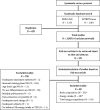Total Energy Expenditure, Energy Intake, and Body Composition in Endurance Athletes Across the Training Season: A Systematic Review
- PMID: 28161872
- PMCID: PMC5292109
- DOI: 10.1186/s40798-017-0076-1
Total Energy Expenditure, Energy Intake, and Body Composition in Endurance Athletes Across the Training Season: A Systematic Review
Abstract
Background: Endurance athletes perform periodized training in order to prepare for main competitions and maximize performance. However, the coupling between alterations of total energy expenditure (TEE), energy intake, and body composition during different seasonal training phases is unclear. So far, no systematic review has assessed fluctuations in TEE, energy intake, and/or body composition in endurance athletes across the training season. The purpose of this study was to (1) systematically analyze TEE, energy intake, and body composition in highly trained athletes of various endurance disciplines and of both sexes and (2) analyze fluctuations in these parameters across the training season.
Methods: An electronic database search was conducted on the SPORTDiscus and MEDLINE (January 1990-31 January 2015) databases using a combination of relevant keywords. Two independent reviewers identified potentially relevant studies. Where a consensus was not reached, a third reviewer was consulted. Original research articles that examined TEE, energy intake, and/or body composition in 18-40-year-old endurance athletes and reported the seasonal training phases of data assessment were included in the review. Articles were excluded if body composition was assessed by skinfold measurements, TEE was assessed by questionnaires, or data could not be split between the sexes. Two reviewers assessed the quality of studies independently. Data on subject characteristics, TEE, energy intake, and/or body composition were extracted from the included studies. Subjects were categorized according to their sex and endurance discipline and each study allocated a weight within categories based on the number of subjects assessed. Extracted data were used to calculate weighted means and standard deviations for parameters of TEE, energy intake, and/or body composition.
Results: From 3589 citations, 321 articles were identified as potentially relevant, with 82 meeting all of the inclusion criteria. TEE of endurance athletes was significantly higher during the competition phase than during the preparation phase (p < 0.001) and significantly higher than energy intake in both phases (p < 0.001). During the competition phase, both body mass and fat-free mass were significantly higher compared to other seasonal training phases (p < 0.05).
Conclusions: Limitations of the present study included insufficient data being available for all seasonal training phases and thus low explanatory power of single parameters. Additionally, the classification of the different seasonal training phases has to be discussed. Male and female endurance athletes show important training seasonal fluctuations in TEE, energy intake, and body composition. Therefore, dietary intake recommendations should take into consideration other factors including the actual training load, TEE, and body composition goals of the athlete.
Figures








Similar articles
-
Alterations in redox homeostasis in the elite endurance athlete.Sports Med. 2015 Mar;45(3):379-409. doi: 10.1007/s40279-014-0276-5. Sports Med. 2015. PMID: 25319354
-
Energy expenditure and dietary intake during high-volume and low-volume training periods among male endurance athletes.Appl Physiol Nutr Metab. 2012 Apr;37(2):199-205. doi: 10.1139/h11-155. Epub 2012 Feb 23. Appl Physiol Nutr Metab. 2012. PMID: 22360344
-
Energy expenditure of athletes' endurance and strength in the light of the Polish energy intake standards.Int J Occup Med Environ Health. 2019 Feb 27;32(1):1-13. doi: 10.13075/ijomeh.1896.01300. Epub 2019 Jan 22. Int J Occup Med Environ Health. 2019. PMID: 30675876
-
Nutritional status of endurance athletes: what is the available information?Arch Latinoam Nutr. 2005 Mar;55(1):15-22. Arch Latinoam Nutr. 2005. PMID: 16187673 Review.
-
Isotope Dilution for Measuring Total Energy Expenditure, Water Turnover, and Total Body Water in Athletes: A Systematic Review.Int J Sport Nutr Exerc Metab. 2025 May 21;35(4):363-382. doi: 10.1123/ijsnem.2024-0225. Print 2025 Jul 1. Int J Sport Nutr Exerc Metab. 2025. PMID: 40404134
Cited by
-
The Impact of a 'Remotely-Delivered' Sports Nutrition Education Program on Dietary Intake and Nutrition Knowledge of Junior Elite Triathletes.Nutrients. 2022 Dec 7;14(24):5203. doi: 10.3390/nu14245203. Nutrients. 2022. PMID: 36558361 Free PMC article.
-
Heterogeneity of endometriosis lesions requires individualisation of diagnosis and treatment and a different approach to research and evidence based medicine.Facts Views Vis Obgyn. 2019 Mar;11(1):57-61. Facts Views Vis Obgyn. 2019. Corrected and republished in: Facts Views Vis Obgyn. 2020 Jan 24;11(3):263. PMID: 31695858 Free PMC article. Corrected and republished.
-
Factors affecting nutritional knowledge, attitude, practices and dietary intake among national players in Kathmandu, Nepal: a cross-sectional study.BMC Sports Sci Med Rehabil. 2023 Jun 30;15(1):73. doi: 10.1186/s13102-023-00691-7. BMC Sports Sci Med Rehabil. 2023. PMID: 37391783 Free PMC article.
-
Evolutionary Echoes: A Four-Day Fasting and Low-Caloric Intake Study on Autonomic Modulation and Physiological Adaptations in Humans.Life (Basel). 2024 Mar 29;14(4):456. doi: 10.3390/life14040456. Life (Basel). 2024. PMID: 38672727 Free PMC article.
-
The Effect of a Hydroxytyrosol-Rich, Olive-Derived Phytocomplex on Aerobic Exercise and Acute Recovery.Nutrients. 2023 Jan 13;15(2):421. doi: 10.3390/nu15020421. Nutrients. 2023. PMID: 36678293 Free PMC article. Clinical Trial.
References
-
- Ravussin E, Bogardus C. Relationship of genetics, age, and physical fitness to daily energy expenditure and fuel utilization. Am J Clin Nutr. 1989;49(5 Suppl):968–75. - PubMed
-
- Zapico AG, Calderon FJ, Benito PJ, Gonzalez CB, Parisi A, Pigozzi F, et al. Evolution of physiological and haematological parameters with training load in elite male road cyclists: a longitudinal study. J Sports Med Phys Fitness. 2007;47(2):191–6. - PubMed
Publication types
LinkOut - more resources
Full Text Sources
Other Literature Sources

